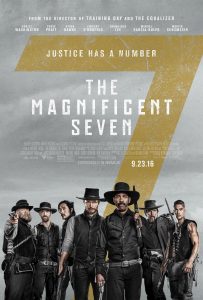
Release Date: September 23, 2016
Cast: Denzel Washington, Chris Pratt, Ethan Hawke, Vincent D’Onofrio, Byung-hun Lee, Manuel Garcia-Fulfo, Martin Sensmeier, Haley Bennett, Peter Sarsgaard
Director: Antoine Fuqua
Studio: LStar Capital, Village Roadshow Pictures, Pin High Productions, Escape Artists
Distributor: Metro-Goldwyn-Mayer Columbia Pictures
Genre(s): Action & Adventure, Western
IMDB | Rotten Tomatoes | Wikipedia
The Magnificent Seven, directed by Antoine Fuqua, may not be the best film of the year, but it’s certainly a fun ride. The film provides everything a person could want from an action-western, without the white-washing and racist representations of POC that is usually associated with this genre (here’s looking at you,Lone Ranger).
This film centers on a small town, Rose Creek, which has been set upon by the industrialist Bartholomew Bogue, who seeks to leach any gold available from the fair valley. Emma Cullen (Haley Bennett) sets out to find individuals who are willing to assist her in her quest for vengeance.
Chisolm (Denzel Washington) is the first of the “seven,” and quickly brings together the remainder of the posse including the quick-fingered and tongued Josh Faraday (Chris Pratt), the conflicted and suave Goodnight Robicheaux (Ethan Hawke), soft-spoken bear of a man Jack Horne (Vincent D’Onofrio), knife wielding Billy Rocks (Byung-hun Lee), Mexican outlaw Vasquez (Manuel Garcia-Rulfo) and finally, Comanche warrior Red Harvest (Martin Sensmeier).
Now this film does suffer in the overall story-telling. It is predictable. You hardly expect these seven to fail. What could possibly make them magnificent if they did? However, it is the journey and characterizations in this film that make it worth watching. Overall, the actors put in memorable performances (I honestly can’t decide which I like the most), and the visuals of an ethnically diverse group led by none other than Denzel Washington is memorable in its own right. The symbolism of the entirely black-clad Chisolm atop a black horse lends itself well to the upside-down nature of these “villains” turned heroes.
The entire film was enhanced by the score of James Horner and Simon Franglen (who completed the score when Horner passed away last year). The score hints at the original theme music, while ultimately sounding like a western as only Horner could provide. And the cinematography of Mauro Fiore matched with the direction of Antoine Fuqua allowed for some striking visuals and almost hauntingly beautiful pans of the west.
The film races along, with quippy commentary – mostly provided by Pratt – and some damn fine gun slinging and horseback riding. It provided everything I wanted from it. It was noTombstone orTrue Grit, but it did improve upon the original and provided a good time to all those in the theater.
Now, I’m going get a bit preachy here and say that perhaps the best part of this film, and the most important, is that director Antoine Fuqua purposefully created a film that includes the classic western tropes, but in order to fix them. Byung-hun Lee is South Korean. Manuel Garcia-Rulfo is from Mexico. And most important of all, Martin Sensmeier is Native American and is an ambassador for the Native Wellness Institute.
For once Hollywood realized that these stories can include individuals from all ethnic backgrounds and that individuals of those heritages can portray them and carry a film. Now, whether or not this consideration will spill over into more of Hollywood remains to be seen, but I for one am grateful for at least this.
Overall, this film was fun and energetic, with just a little bit of heart. I’d give it 3 ½ crooked, sheriff badges out of five.
Final thoughts: Before any other critics disparage this film for being too “commercial,” remember that the Hollywood Reporter wrote this of the original: “In adding so-called commercial values, a good picture was sabotaged.” You just can’t win with critics, can ya?